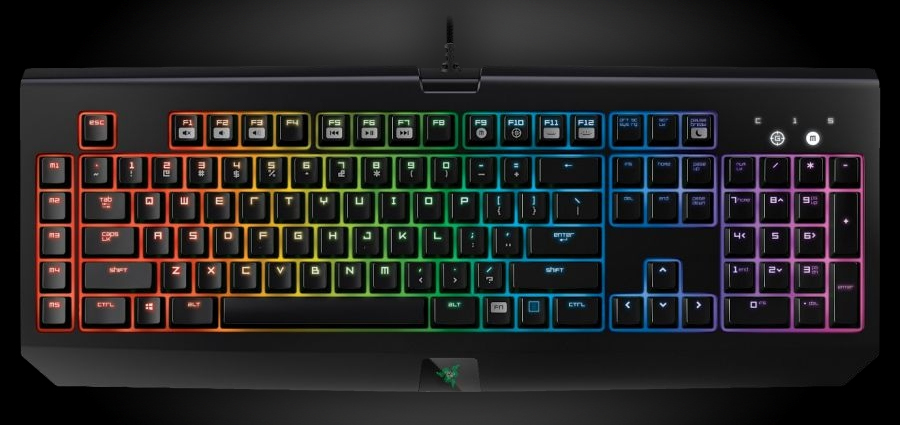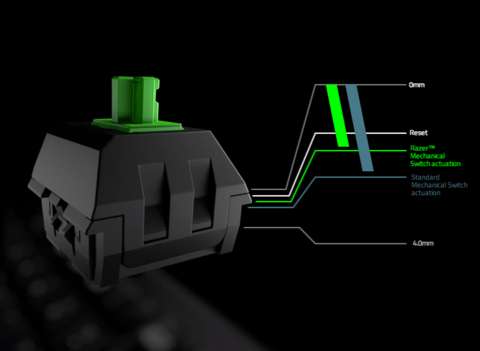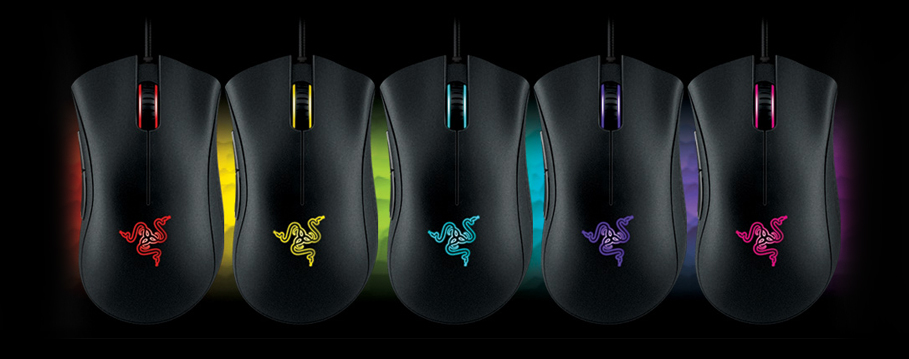Hardware manufacturers have been adding lights to gaming peripherals for years, but gone are the days when you have to settle for one color per device. Adjustable, full spectrum RGB lighting has arrived, and as noted in our Corsair Gaming K70 keyboard review, it adds significant character to otherwise standard gear.
Now, Razer's joined the RGB party, updating four existing peripherals with multicolor lighting to its lineup, including the Death Adder mouse, the 7.1 channel Kraken headset, and most notably, the BlackWidow mechanical keyboard. While colorful lighting effects may add an enticing amount of flash to a headset or mouse, there's potential that a keyboard with individually lit keys might provide an actual advantage during gameplay.
BlackWidow Chroma Keyboard - $169.99
The benefit of illuminated keys is debatable, but the overwhelming consensus is that key switches, the mechanism that registers each keystroke, can make or break a gaming keyboard. A key switch determines many things, including the depth at which a keystroke is actuated and whether or not there's any associated feedback. Razer's stepped away from using the popular Cherry MX switches in recent months, opting for their own custom solution instead. However, if you compared the BlackWidow Chroma's switches to Cherry's blue MX variant, you might not be able to tell the difference between the two. Both exhibit pronounced tactile and audible feedback, and the travel distance for both switches is practically identical. If clicky keys aren't your cup of tea, Razer offers a stealth version of the BlackWidow Chroma for the same price as the mechanical version.

For the Chroma version of the BlackWidow, Razer's installed an RGB LED in the back of each switch housing that can project any of 16.8 million colors. Razer's implementation is interesting because, on the one hand, the exposed LED beneath each key emits an extremely bright light, but this unrestrained projection means that the light bleeds out from beneath each key. This isn't inherently bad, but if you're looking for more succinct lighting that only illuminates the actual face of the keys, your only option is to dial down the brightness of the BlackWidow, or, consider another keyboard altogether.
Per-key lighting opens the door for impressive lighting effects, but more than the hardware, it's the software that's in the driver's seat. We liked the fact that Corsair's suite for the K70 is robust, allowing for an incredible amount of fine tuning. However, it's not intuitive, with many of the more powerful options laying buried in menus that are difficult to identify and configure. Razer's Synapse software is much easier to use, but that's because it has a slimmer set of options overall.

Let's start with the basics. Synapse allows you to set a unique color for each key on the BlackWidow, and you can force individual configurations to apply automatically when a specific game or application is opened. If you have trouble identifying or remembering the entire range of hotkeys for a given game, isolating keys with distinct colors is a great way to give yourself a leg up. Thankfully, configuring individual keys in Synapse is easy, and it takes only a few clicks to save a profile that points to a specific application or game.
Contextual hotkeys aside, BlackWidow's other lighting options exist purely for the sake of eye candy. The "wave" setting activates a rolling rainbow of color across the entire keyboard, while "spectrum cycling" mode makes every key transition through the entire range of colors in unison. You can limit this effect to two colors and introduce fluctuating brightness by choosing the "breathing" option. Lastly, "reactive" mode causes keys to light up in a color of your choosing for a specified length of time after they've been pressed, before gradually fading into darkness.
These are all decent options for anyone who's interested in brightening up their keyboard with a little color, but it's a relatively small set of tools when compared to what's on offer from the competition. Again, with Corsair's software, you have full control over every key's behavior, even relative to other keys on the board. Pressing one key can set off a chain reaction of effects, for example. Yes, Corsair's software suffers from confusing menus, but it's evidence that there's a lot of potential for customizable lighting. Currently, Razer's solution just scratches the surface. But, if you're only interested in customizing your layout, key by key, this isn't an issue. In that case, the BlackWidow Chroma is wholly sufficient, and it's easy to recommend as it's a great gaming keyboard in general. It's easy to navigate, has responsive key switches, and touts what are probably the brightest key lights on the market.
Death Adder Chroma Mouse - $69.99
The Death Adder Chroma mouse's lighting options are simple, but there's only so much you can expect from a mouse in this regard. As it stands, both the scroll wheel and the Razer logo on the palm rest have configurable RGB lighting to play with. The logo can be set to a static color, or put into ether the spectrum cycling and breathing modes, while the scroll wheel only displays a static color or cycling effects. If you're using more than one Razer Chroma device, Synapse can sync the effects and colors across the board by checking a single box in the configuration menu, so that colors shift likewise in spectrum mode, for example.

In terms of comfort and performance, the Death Adder is a straightforward but good mouse. It remains comfortable during bouts of prolonged use, and there are plenty of customization options within Synapse that allow you to tailor sensitivity and inputs to your liking. While the Death Adder Chroma is the same price as the standard model, the two have different specifications beyond lighting: the DPI rating on the Chroma model has been bumped up to 10,000 DPI from 6,400 DPI. Of course, not everyone needs that kind of sensitivity, but it's good to have just in case. Considering the increased sensitivity and the addition of RGB lighting, there's no practical reason to consider the traditional Death Adder in a world where the Chroma version exists.
Kraken 7.1 Chroma Headset - $99.99
We've also had some heads and hands-on time with the Kraken 7.1 Chroma USB headset, which has an Synapse controlled Razer logo on each side. Like the Death Adder, the Kraken's lighting options are simpler than the BlackWidow's, featuring only static, spectrum cycling, and breathing modes.
More importantly, the Kraken headset sounds great for a $99 headset, and it's plenty comfortable thanks to the faux leather ear pads and a flexible headband with light padding. The circumaural cups have grating on the outside, giving the appearance of an open-ear design, but at reasonable volume levels, there's no perceptible sound leakage. Likewise, you don't pick up much outside noise on the microphone, which sounds great in nearly all conditions thanks to effective audio filtering through Synapse.

In some cases, closed ear, surround sound headsets have problems with directionality as the audio tends to bounce around within the ear cup before hitting your ear. Razer's 7.1 enabled Kraken Chroma doesn't suffer from this issue, and it even has an easy to use configuration tool in Synapse for calibrating the position of each virtual channel. With a proper setup, you can easily tell the difference from sounds that are coming ahead and to the right, versus from behind and to the right, for example.
In fact, almost every aspect of the Kraken headset can be tuned in an easy and straightforward manner. You can adjust various frequencies using the Synapse equalizer, automatically normalize various audio feeds to the same volume, and filter incoming voice communication for greater clarity. At $99.99, the Kraken Chroma headset is considered mid-range among Razer's offerings, but it's got pretty much everything you need from a gaming headset. The Kraken 7.1 Chroma also works with PlayStation 4, but unfortunately there's no surround sound support as that's tied to the synapse software on PC.
Though the Kraken 7.1 Chroma is just a cosmetic upgrade, the Death Adder and BlackWidow Chroma are certainly a step up from their non-illuminated cousins. While the Kraken and Death Adder cost the same as previous models, the BlackWidow Chroma is another story. At $169.99, it's $40 more than the standard backlit BlackWidow Ultimate, and $70 more expensive than the standard BlackWidow without backlighting. It's an expensive upgrade, but if you value lighting and believe that you'd benefit from uniquely colored hotkeys, the BlackWidow Chroma would be an excellent addition to your gaming PC setup.
